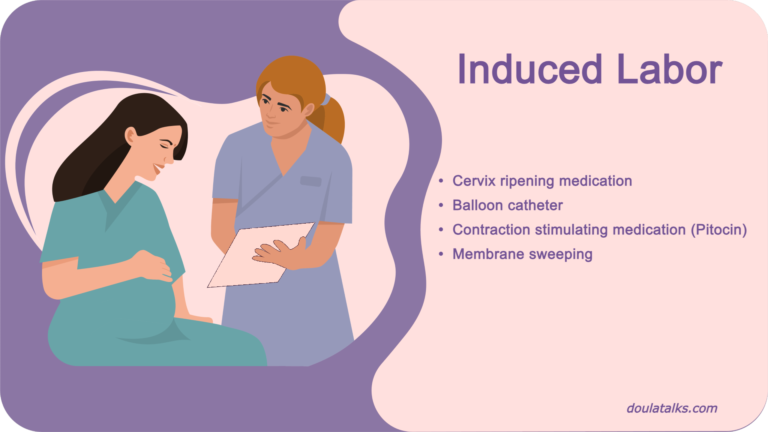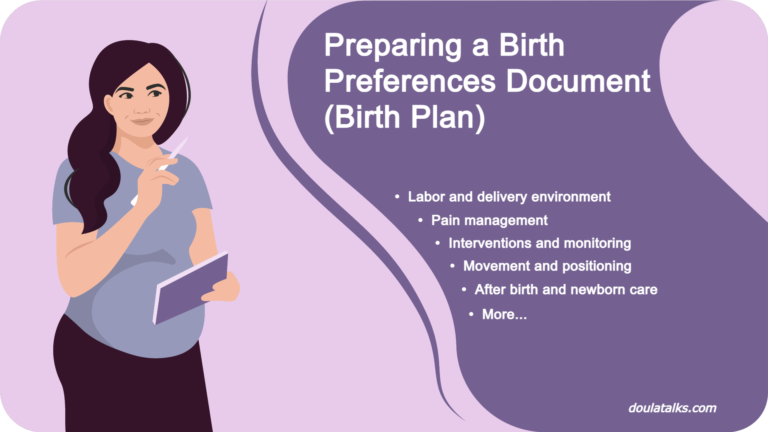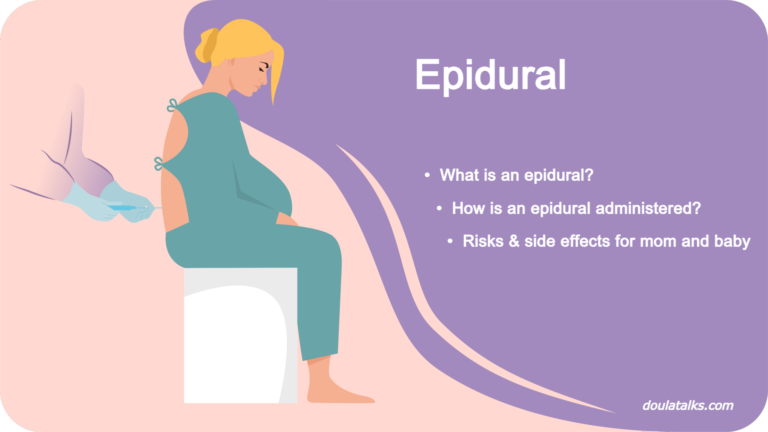In This Article:
- Oxytocin and its role in labor induction
- The right time to use Pitocin
- Administration and dosage of Pitocin
- Does Pitocin affect dilation?
- Will I be able to rest while receiving Pitocin?
- How to manage pain while on Pitocin
- Understanding the risks: common side effects of Pitocin for mom and baby
- Does the use of Pitocin increase the risk of a C-section?
- Boosting your oxytocin: tips and techniques for increasing hormone levels naturally
- Conclusion
In the last few years, there has been a significant rise in labor induction rates in the U.S. The medical community happily adopted the ARRIVE trial without questioning it, and doctors began recommending induction to a growing number of women at 39-40 weeks pregnant, regardless of the subjective medical situation.
Some medical conditions indeed require medical intervention. However, an induction is a tool that is best used in moderation and only when absolutely needed.
There are different methods or medications that are used to induce labor. This article will review the use of Pitocin.
Pitocin has had a very bad reputation over the years. I feel that recently, as it became more and more clear what the best ways to use Pitocin are, it became safer, can allow more control over the process, and, when used correctly and for the right reasons, it is a good tool to have.
Oxytocin and its role in labor induction
Pitocin is a synthetic form of the hormone oxytocin, which is naturally produced by the body. Oxytocin is also known as the “love hormone” and is involved in various physiological processes, including stimulation of contractions in the uterus during labor and the release of breast milk.
The mechanism of action of Pitocin is like that of the natural oxytocin hormone. It acts on the uterine smooth muscle to cause rhythmic contractions, to either start labor artificially or to augment slow or irregular contractions.
The right time to use Pitocin
For best results, Pitocin should only be used when it is determined that the cervix is ripe and ready. The cervix must be soft enough to allow contractions to be effective and, in turn, get the cervix to shorten, which will then cause it to open (dilate). If the cervix is not ready, there might be a need to offer prostaglandins (either vaginally with Cervidil, or orally with Misoprostol/Zitotec).
Also Read:
Administration and dosage of Pitocin
Pitocin is typically administered intravenously (IV) through an IV line inserted into a vein in the arm. It is delivered continuously through an infusion pump, which is carefully monitored to ensure the correct dosage is delivered. The dosage of Pitocin depends on several factors, including the woman’s gestational age, the stage of labor, the strength and frequency of contractions, and the health of the baby. In general, the initial dosage of Pitocin is low and is gradually increased until the desired effect is achieved.
The half-life of oxytocin in the bloodstream is about 3 to 5 minutes, meaning that it is rapidly metabolized and eliminated from the body.
Does Pitocin affect dilation?
Pitocin can help stimulate uterine contractions and facilitate dilation of the cervix during labor. However, the rate at which dilation occurs varies and can depend on several factors, including the woman’s previous pregnancy history, her age, and the position of the baby.
In general, dilation of the cervix typically occurs gradually over the course of several hours to a few days. The average time it takes to progress from 1 cm to 10 cm of dilation is usually between 6 to 20 hours, although this can vary widely and can be shorter or longer depending on the individual woman and the specific circumstances of her labor.
It is important to note that while Pitocin can help to speed up the dilation process, it can also increase the risk of certain complications, such as uterine hyperstimulation or fetal distress.
Will I be able to rest while receiving Pitocin?
The purpose of using Pitocin is to help labor progress, and just like with spontaneous or natural contractions, we hope that at some point the contractions are intense enough to promote labor. In that case, sleeping or even lying down will not be comfortable.
I always suggest getting as much rest before labor really kicks in, and usually, when Pitocin levels are low, it is still possible. When it gets uncomfortable to rest, you can start walking around the room, get on all fours in bed, sit on a birthing ball, and even use a shower (the nurse can cover the IV tubes).
How to manage pain while on Pitocin
Pain during labor and delivery is a subjective experience, and women may experience pain differently.
The pain associated with Pitocin-induced contractions can vary from woman to woman. Although Pitocin-induced contractions can be stronger and more frequent than natural contractions, it may also depend on several factors including individual pain tolerance, the stage of labor, and the strength and frequency of the contractions.
Same as with natural contractions, you can choose to use pain management techniques, such as breathing exercises, massage, shower/bath, and pain medication.
Understanding the risks: common side effects of Pitocin for mom and baby
Pitocin is a commonly used medication, but like all medications, it has associated risks and side effects. Some of the most common risks and side effects of Pitocin include:
Uterine hyperstimulation
Pitocin can cause the uterus to contract too strongly or too frequently, which can lead to uterine hyperstimulation and distress for both the woman and the fetus.
Nausea and vomiting
Pitocin can cause nausea and vomiting in some women, especially if the dosage is too high.
Fetal distress
Pitocin can increase the risk of fetal distress, which can be indicated by changes in the fetal heart rate or patterns of fetal movement.
Monitoring / limited mobility
The use of Pitocin requires women to be continuously monitored, and that may limit mobility, which in turn may result in an increased feeling of discomfort and pain as contractions become more frequent.
Although these side effects may sound scary or worrisome, in my experience they are not common. The fact that Pitocin leaves the body quickly, which means it is manageable and controlled, makes it safe.
Does the use of Pitocin increase the risk of a C-section?
With regards to the risk of C-section, there is some evidence to suggest that the use of Pitocin to induce or augment labor can increase the risk of a C-section, especially if the labor is prolonged or complicated by uterine hyperstimulation or fetal distress. However, it is important to note that C-sections can also be necessary for other reasons not related to Pitocin, such as fetal distress for other reasons or other complications during labor and delivery.
Boosting your oxytocin: tips and techniques for increasing hormone levels naturally
There are several methods to naturally increase oxytocin levels in the body, including:
- Physical touch: Engaging in physical touch such as hugging, holding hands, or massaging has been shown to increase oxytocin levels.
- Sexual activity: Sexual stimulation, especially orgasm, has been shown to increase oxytocin levels.
- Breastfeeding: Nursing a baby can increase oxytocin levels in both the mother and the baby. Nipple stimulation, not nursing, can also have the same effect.
- Emotional connection: Spending time with loved ones and engaging in activities that foster emotional connection, such as talking, laughing, or spending time in nature, can increase oxytocin levels.
- Exercise: Moderate exercise has been shown to increase oxytocin levels, especially activities that involve rhythmic movement, such as dancing or yoga.
It is important to note that while these activities can increase oxytocin levels, they should be approached with caution in individuals with certain medical conditions or restrictions (after a C-section, for example) or taking certain medications. If you are not sure, consult your doctor or midwife.
Conclusion
Although I feel that there is a recent inflation in inductions, sometimes it is necessary.
It is important that when you have a conversation with your health provider, ask a lot of questions, focus on YOUR specific condition and the condition of your baby, and do not talk about a theoretical generic woman to whom your doctor may be referring when mentioning information. The decision should be the right one specifically for you.
At the end of the day, you are the one making decisions for yourself and your baby, so make sure you are well-informed before making them.
I wish you a wonderful and happy labor!
Questions?
If you have any questions about this topic/article, please feel free to contact me through email at: liat@doulatalks.com
Liat Salomon is a certified doula since 2010 and is working in the San Francisco Bay Area in California. She has assisted in hundreds of births and has extensive experience with VBAC.
The information in this article does not constitute medical advice or diagnosis. It is meant for informational purposes only.
Related Articles:











